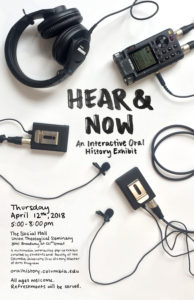Hear & Now:
An Interactive Oral History Exhibition
By the 2017 OHMA Cohort, April 12, 2018
Curated by Desmond Austin-Miller, Samantha Lombard,
Carlin Zia & OHMA Co-Director Amy Starecheski
Check out the full event description on the OHMA website.

From grade school we learn that History is the Thing that Happened. The bell rings and we leave History in a closed textbook, a specific classroom, and carry on with our day. We consume media, we process news, we have conversations, we think about tomorrow. But in doing so we are participating in history: constantly orienting ourselves in relation to existing and selected narratives.
HEAR & NOW is a multimedia pop-up presenting the fieldwork of scholars who are also activists, researchers who are also storytellers, oral historians who are also community members. We, the members of OHMA, are intent on confronting our own roles, rights, and responsibilities as producers of knowledge, and urgently embrace the changeability of history. In many ways, this exhibit is an intervention. The telling of the past has been actively and hegemonically filtered, but we can work to recuperate silenced narratives and to change what capital-H History remembers moving forward. Let HEAR & NOW represent one of many efforts this year to recuperate these narratives.
The exhibit was created by the 2017 cohort of the Oral History MA program and curated by OHMA Co-Director Amy Starecheski and current students Desmond Austin-Miller, Samantha Lombard, and Carlin Zia.
Exhibits included:
Life Imitating Art: The Legacy of Marlon Riggs in Today’s America by Brad Bailey
A perspective on the legacy of filmmaker Marlon Riggs in today’s America.
Buried Alive by Elyse Blennerhassett
Based on years of phone calls with two men who were sentenced to juvenile life without parole 30 years ago, “Buried Alive” examines the relationship between place, memory, and desire within the US prison landscape, “through two short films “Never Enough Time” and “Spooncake”and the art and writings of incarcerated men.
Comparative Classrooms: Teaching to Transgress by Valerie Fendt
How do we value education, who benefits from it, and what are the impacts of Columbia classes inside of state correctional facilities?
Spectrum of Spirituality by Alissa Funderburk
Encounter an array of spiritual beliefs and practices by listening to personal accounts and placing your own memories on the spectrum of spirituality.
‘I’ll Fly Away’: An Oral History of Love, Loss and Leave-taking by Rozanne Gooding Silverwood
“I’m going to be a mess talking about this.” Listening in on one family’s conversations about death.
Ballots Over Bars by Elly Kalfus
You are invited to sit in on an imagined meeting of the MCI-Norfolk Lifers Group – come and listen to formerly incarcerated people in Massachusetts share why they care about the right to vote and how they organized for universal suffrage while in prison.
Restoring Memory by Tomoko Kubota
By colorizing monochrome photos taken before, during, and after World War II, the survivors of the War start to restore vivid memories of their daily lives.
The Picture the Homeless Oral History Project by Lynn Lewis
By inviting engagement with its narrators and archival materials, the Picture the Homeless Oral History Project asks visitors to move beyond empathy and the framework of charity to understand that homelessness is a social justice question.
Why We Stayed: The Experiences of Poland’s Remaining Jews, 1945-2008 by Filip Mazurczak
Presenting the experiences of five Polish Jews born between 1932 and 1940 who still live in Poland, this exhibit challenges the false narrative that Jewish life in Poland ended in 1945 or in 1968.
Who/What/Where? by Kyna Patel
This participatory exhibit invites visitors to reflect upon the people, places, or things that have helped shape who they are today in a life history interview context.
Down to the Docks: The Longshoreman Speaks Up by Meave Sheehan
This is an investigation into the figure of the dock worker, also known as a longshoreman or stevedore, who was once a formidable local archetype in the New York area.
ABANDONED: Stories from Survivors of Gun Violence by Holly Werner-Thomas
The stories of survivors of gun violence are not easy to listen to, but they’re important to hear.
Harlem Small Business by Yameng Xia
The Harlem Small Business exhibit presents two small business stories to inspire high school students to learn from their spirits.
Come, to the love of Christ by Yiyi Zhang
An intimate space and a window into the lives of Christians from different traditions whose stories shared a touch of joy and sorrow, a struggle of faith and doubt, yet, embraced by a love of Christ.
Carmine’s House by Dian Zi
Experience life through the eyes of Carmine, a son, a brother, an adult with autism.

































2 thoughts on “HEAR & NOW (2018)”
Comments are closed.